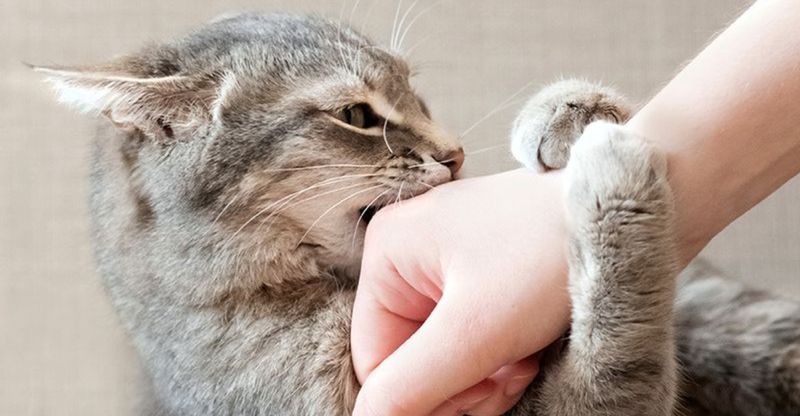📖 Table of Content:
Cats are known for their independent and mysterious nature, but they have specific boundaries that should not be ignored. When these limits are crossed, even the calmest cat can display sudden aggression, such as scratching, biting, or hissing. Recognizing the signs that lead to these behaviors is essential for maintaining a peaceful and respectful environment.
Unintentional mistakes by owners often contribute to stress and discomfort for cats. Actions like invading their personal space, sudden movements, or loud noises can trigger defensive responses. It’s important to understand these subtle signals to avoid upsetting the cat and to create a more harmonious relationship.
By learning what triggers a cat’s aggression and respecting their boundaries, it becomes easier to foster trust. Building this understanding not only prevents stress for the cat but also encourages a calmer atmosphere at home. A few adjustments in behavior can make all the difference in strengthening the bond between cat and owner.
1. Forced Belly Rubs
Most cats display their bellies as a sign of trust, not an invitation to touch. When you reach for those soft tummy spots, your cat might feel threatened and vulnerable. Their natural defense is to grab your hand with their claws and teeth.
Cats have sensitive nerve endings on their stomachs, and what seems like a pleasant pet to you might feel overwhelming to them. Instead, focus on petting areas they clearly enjoy, like behind the ears or under the chin.
Some cats may tolerate brief belly contact, but always watch for twitching tails or dilated pupils – warning signs that your furry friend has had enough.
2. Punishment for Natural Behaviors
Yelling at your cat for scratching furniture or jumping on counters creates fear and confusion. Cats aren’t being deliberately naughty – they’re following natural instincts that have helped their species survive for thousands of years.
When punished, cats don’t connect their behavior with your reaction. They simply learn to fear you. This breakdown in trust often results in defensive aggression when you approach them later.
A better approach involves providing appropriate outlets for natural behaviors, like scratching posts and climbing trees, while using positive reinforcement when they use these alternatives correctly.
3. Ignoring Body Language Cues
Through small but noticeable body movements, cats communicate their emotional state. Signs like flattened ears, puffed tails, and skin twitching indicate a cat is feeling threatened. Pushing past these warnings by continuing to pet them can lead to unpleasant reactions.
Many bites happen because owners miss these early warnings or believe their cat will “get over it” if they continue. This misreading of communication damages trust and reinforces aggressive responses.
Taking time to learn feline body language helps prevent most aggressive episodes. When you notice stress signals, simply give your cat space and time to calm down before trying to interact again.
4. Rough Play With Hands
Wrestling with your kitten using bare hands might seem cute at first. The problem develops when they grow up unable to distinguish between playtime and regular handling. Adult cats with sharp claws and strong jaws can cause serious injuries when playing roughly.
This confusion makes everyday interactions like medicating, grooming, or petting potentially dangerous. Your cat learns that hands are toys to be attacked rather than sources of gentle touch.
Always use appropriate toys like wands or stuffed mice for active play. This clear boundary helps your cat understand when it’s okay to pounce and bite versus when to stay calm during handling.
5. Skipping Regular Playtime
To stay mentally and physically healthy, cats need regular opportunities to channel their hunting energy. Without structured playtime, they may turn this energy into disruptive actions like pouncing on your ankles or hiding to launch surprise attacks.
Many owners mistakenly believe that indoor cats, especially older ones, don’t need much stimulation. This lack of engagement creates boredom and frustration, which frequently manifests as aggression toward owners or other pets.
Two 10-15 minute play sessions daily can dramatically reduce unwanted aggressive behaviors. Using toys that mimic prey movements healthily satisfies their hunting instincts, leading to a calmer, more content kitty.
6. Forcing Medication or Grooming
Restraining your cat too firmly during necessary care creates negative associations that last long after the event. Cats remember these stressful experiences and may become defensive even when you’re simply approaching them normally.
Rushed grooming sessions or medicine administration teach cats to fear handling. They learn to associate your hands with discomfort, leading to preemptive strikes to avoid being caught again.
Training your cat to accept touching different body parts gradually builds tolerance. Using positive reinforcement like treats during brief, gentle handling sessions helps create positive associations that make necessary care much safer for everyone.
7. Disturbing Their Safe Spaces
To feel truly secure, cats need spaces they can call their own. Disturbing them by reaching into their hiding spots, like under the bed or behind furniture, can break their trust and make them feel unsafe.
When cornered without escape options, even the gentlest cats may resort to aggression as self-defense. This survival response is hardwired into their DNA from thousands of years as both predator and prey in the wild.
Respect your cat’s hideaways as off-limits zones. If you need your cat to come out, use treats or toys to entice them rather than forcing physical removal. This approach preserves their trust and prevents fear-based aggression.
8. Introducing New Pets Incorrectly
Bringing home a new pet without proper introduction protocols can trigger severe territorial aggression. Cats are naturally territorial, and sudden new animal appearances feel like invasions requiring defensive action.
This stress often redirects toward owners who try to intervene during conflicts. Even previously affectionate cats may bite or scratch their humans when overwhelmed by territorial threats.
Proper introductions involve keeping new animals separated initially, exchanging scents gradually, and allowing visual contact before physical meetings. This process may take weeks, but prevents the long-term aggression problems that come from rushed introductions and territorial disputes.
9. Environmental Stressors
Loud music, frequent visitors, construction noise, or chaotic households can push cats past their stress tolerance thresholds. Cats thrive on predictability and control over their surroundings.
When constantly bombarded with environmental stressors, cats may enter a heightened state of anxiety. In this state, even minor triggers like a sudden movement can spark aggressive outbursts that seem unprovoked to owners.
Creating quiet zones with hiding spots, maintaining consistent daily routines, and using calming pheromone products can help sensitive cats cope with unavoidable changes. Recognizing your cat’s sensitivity level allows you to adjust the environment before stress escalates to aggression.









